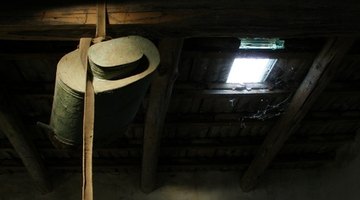How to Install Solar Board Insulation
Solar board insulation acts as a radiant barrier that reflects heat energy from the sun. Solar board can either consist of a type of radiant barrier sheeting for roofs and walls or a combination of oriented strand board (OSB) with a lamination of heat-reflection foil on it. Insulating attics can reduce the amount of heat they receive from the sun, lowering the temperature in the attic by up to 30 degrees Fahrenheit. This heat dissipation helps your heating and air-conditioning system last longer and reduces energy bills.

-
Nail 1-inch furring along the side of all rafters and gables in attic where they face the roof of the house using a hammer and 8d nails.
-
Measure the size of the rafters where you plan to install the solar insulation board with a measuring tape, transfer these measurements to the insulation and cut it to size with a utility knife.
-
Place a layer of shingle underlayment or #15 roofing felt onto your roof deck to protect the solar board from the elements until you can install the shingles. Start driving the plastic capped roofing felt nails 12 inches in from the outer edge of the roofing felt. Position them a staggered pattern, alternating between a row of nails 9 inches apart and another row of nails 18 inches apart to attach the felt securely to the roof.
-
Check the alignment of the rafters with a level and drafting square to ensure they are square and even. Set the solar board panels foil side down, facing the interior of the attic, laying them on the gables of your attic. Plan to allow an airspace of 3/4 inch between the foil surface and other attic building materials; allow 1/8 inch between the panel's ends and edges. Use a level to ensure you have installed the panels squarely and lined them up uniformly, then nail them into place.
References
Tips
- If you expect a delay in shingling your roof, use the heavier #30 roofing felt instead to give your solar board more protection from the elements.
Warnings
- Do not allow your solar insulation board to become wet. The water will encourage mold to grow on it.
- Do not let the foiled surface of the solar board come into contact with insulation or other building materials, it is delicate and can be easily damaged.
Writer Bio
Alexis Rohlin is a professional writer for various websites. She has produced works for Red Anvil Publishing and was one of the top 10 finalists in the 2007 Midnight Hour Short Story Contest for OnceWritten.com. Rohlin holds a Bachelor of Fine Arts in English from Madonna University.
Photo Credits
- retraite image by matteo NATALE from Fotolia.com
More Articles



